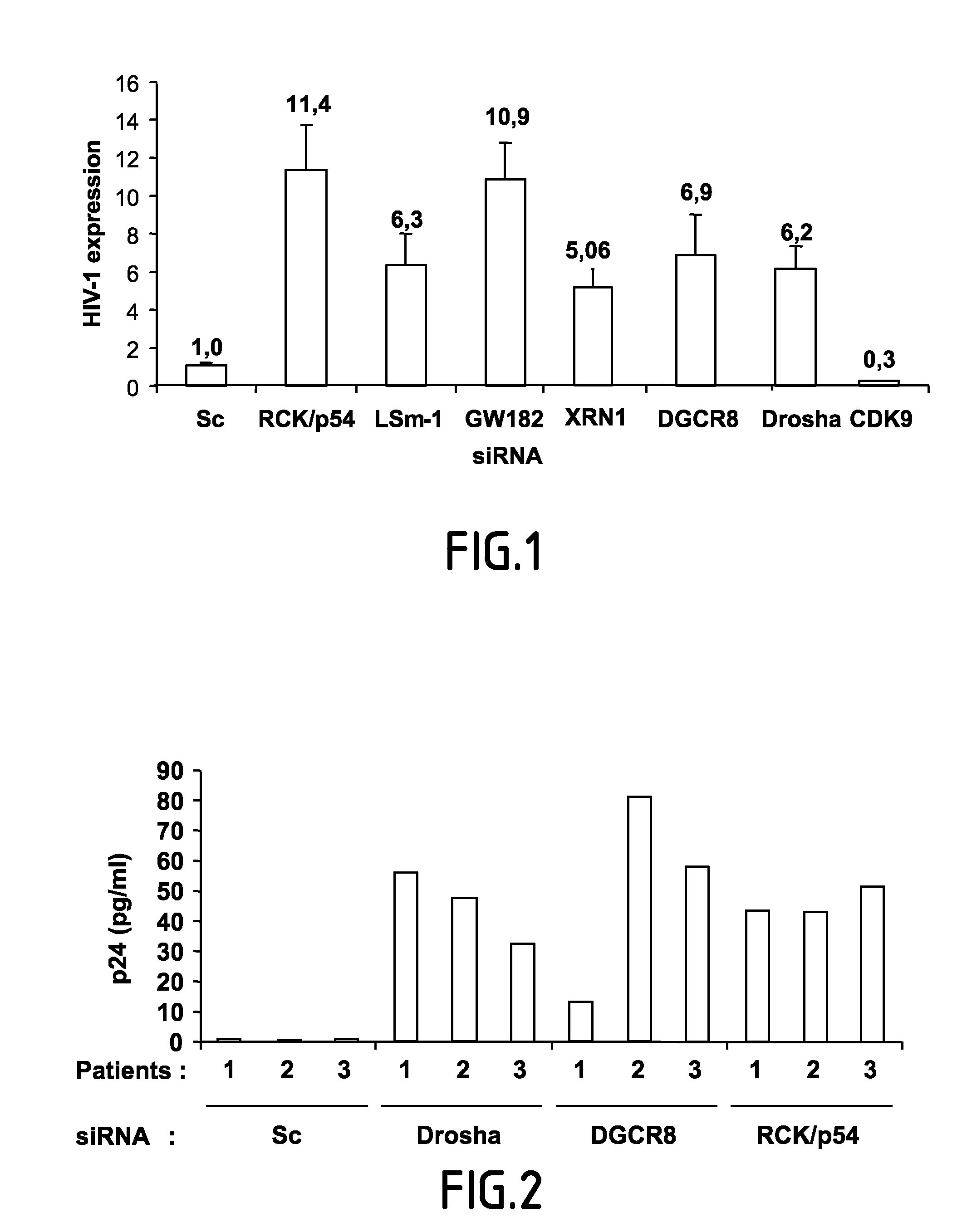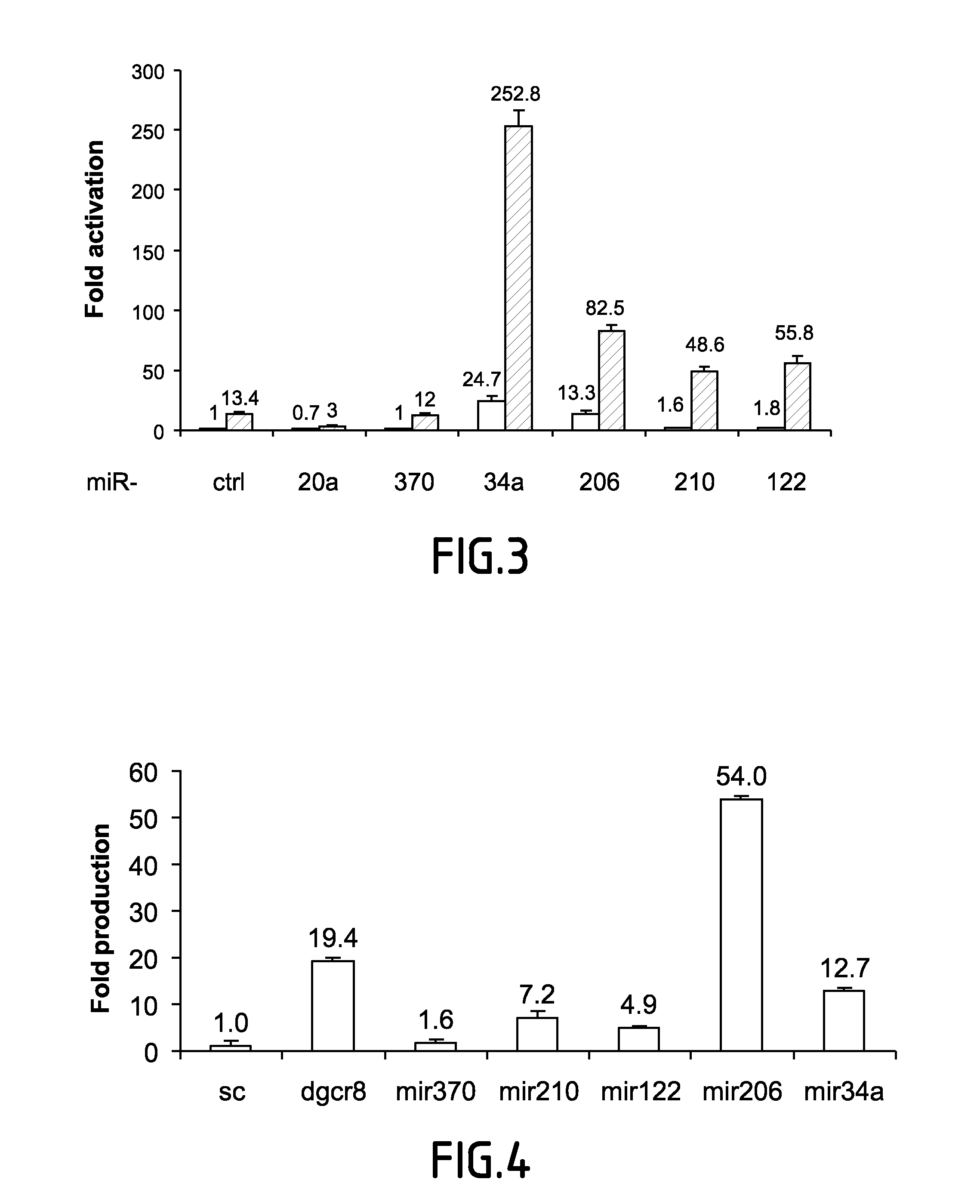Compositions and methods for treating retrovirus infections
a technology for retrovirus infections and compositions, applied in the field of compositions and methods for treating retrovirus infections, can solve the problems of infection reactivation, major problem of viral latency, and constant risk
- Summary
- Abstract
- Description
- Claims
- Application Information
AI Technical Summary
Benefits of technology
Problems solved by technology
Method used
Image
Examples
example 1
MiRNA Effectors Are Repressors of HIV-1 Gene Expression
[0095]To investigate whether RNAi effectors regulate HIV-1 replication, virus replication was analyzed in cells where expression of RNAi effectors was reduced using specific siRNA.
Methods
[0096]HeLa cells were transfected with siRNA as indicated in Triboulet et al. (2007) Science 315 (5818):1579-82 which is incorporated herein by reference. 48 hours post transfection, cells were analyzed for RCK / p54, LSm-1, GW182, XRN1, DGCR8, DROSHA and CDK9 expression by western blot, or infected with a single round infectious virus (HIV-1-VSV-luc) and cell extracts were measured for luciferase activity 48 hrs after infection. RCK / p54 restricts HIV-1 mRNA association with polysomes. Cytoplasmic extracts from HeLa cells that were transfected with the indicated siRNA and infected with HIV-1-VSVG-luc were run on glycerol gradient (7% to 47%). Fractions were collected and their RNA contents were monitored by measuring absorbance (OD) at 254 nm. HIV...
example 2
HIV-1mRNA is Physically Associated with Argonaute2 and Co-Localizes With Protein Required for miRNA-Mediated Silencing
[0099]The physical interaction between RNAi effectors and HIV-1 mRNA was investigated.
Methods
[0100]HeLa cells were transfected with HIV-1 molecular clone pNL4-3, Myc-Ago2 or Myc-AgoPAZ9 as indicated. 48 hrs later cells were harvested and cytoplasmic extracts were prepared. Total RNA was purified from a fraction of harvested cells while the rest was subjected to immunoprecipitation using anti-Myc antibody. After washing, a fraction was used to analyze the amount of Myc-Ago2 and Myc-AgoPAZ9 immunoprecipitated by western blot and the rest of the Myc-IPs was used for RNA extraction. HIV-1 mRNAs (TAR and unspliced), Hdm2 and GAPDH mRNA were quantified from total RNA or from Myc immunoprecipitated mRNPs by RT-PCR using specific oligonucleotides. The experiment was also performed using 32P-labelled nucleotides in the PCR reaction. PCR products were visualized by autoradiogr...
example 3
Accumulation of HIV-1 mRNA in P-Bodies Limits Virus Replication and is Independent of A3G-Mediated HIV-1 Repression
Methods
[0103]HeLa CD4+ cells were transfected with sRNA as indicated. 48 hrs post transfection cells were analyzed for RCK / p54 and LSm-1 expression by western blot or infected with equal amount of HIV-1. Virus production was monitored 48 hrs post infection by measuring p24 antigen in culture supernatant. To analyze the infectivity of the virions produced from the different sRNA transfected HeLa cells, equal volumes of supernatant from sRNA transfected Hela CD4+ were used to re-infect HeLa CD4+ cells. P24 antigen was measured in culture supernatant 48 hrs post infection. APOBEC3G and RNAi effectors-mediated HIV-1 inhibition involves different mechanisms. HeLa CD4+ cells were transfected with the indicated sRNA. 48 hrs later cells were analyzed for RCK / p54 and LSm-1 expression or co-transfected with pNL4-3Dvif (lacking vif gene) and pcDNA or expression vectors for wild-ty...
PUM
| Property | Measurement | Unit |
|---|---|---|
| length | aaaaa | aaaaa |
| resistance | aaaaa | aaaaa |
| reactivity | aaaaa | aaaaa |
Abstract
Description
Claims
Application Information
 Login to View More
Login to View More - R&D
- Intellectual Property
- Life Sciences
- Materials
- Tech Scout
- Unparalleled Data Quality
- Higher Quality Content
- 60% Fewer Hallucinations
Browse by: Latest US Patents, China's latest patents, Technical Efficacy Thesaurus, Application Domain, Technology Topic, Popular Technical Reports.
© 2025 PatSnap. All rights reserved.Legal|Privacy policy|Modern Slavery Act Transparency Statement|Sitemap|About US| Contact US: help@patsnap.com



